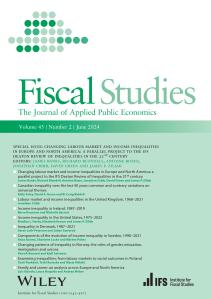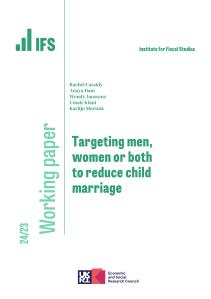Summary
New figures show that men tend to spend longer commuting to work than women. IFS analysis shows that this ‘gender commuting gap’ starts to widen after the birth of the first child in the family and continues to grow for around a decade after that. This bears a striking resemblance to the evolution of the gender wage gap.
- Men tend to spend longer travelling from home to work than women, according to new statistics from the ONS. For example, one in four female workers have a commuting time of more than half an hour, compared to one in three male workers; and 43% of women get to work in no more than 15 minutes, compared to 34% of men.
- New work at the IFS shows that women’s commuting times fall significantly after the birth of their first child while men’s do not. It is mostly what happens during this period of life which drives the overall ‘gender commuting gap’ highlighted by the ONS.
- This gender commuting gap may be linked to the gender wage gap, which also really opens up after the arrival of children in the family. If women take work closer to home because of caring responsibilities, they may be less likely to find a job well matched to their skills or with a high-paying employer. When setting wages employers may also be able to exploit the fact that mothers are only comparing those wage offers to a relatively local set of alternative employers. Further research at the IFS will be examining these possibilities.
The Office for National Statistics (ONS) has today published interesting new statistics on the commuting patterns of men and women in the UK. It shows that men tend to spend longer travelling from home to work than women. This ‘gender commuting gap’ is of some interest in its own right, but also in light of its potential link to the gender wage gap, which all the major UK political parties are committed to reducing. This observation sheds further light on the gender commuting gap described today by the ONS, and discusses its potential relevance for our efforts to understand the causes of the gender wage gap.
The ONS statistics show that about one in four female workers take at least half an hour to get to work, compared to one in three male workers; and 43% of women get to work in no more than 15 minutes, compared to 34% of men. The ONS also document how this varies by region. However, they do not show how the patterns vary by age or family circumstances, which are in fact crucial to understanding what drives commuting differences between men and women. The more moderate overall gender commuting gap documented by the ONS is driven largely by what happens during a particular period of life.
Using a different data source, we can track the commuting patterns (measured by reported time taken to get to work) of the same people before and after they have children. Figure 1 shows that, before childbirth, women have slightly shorter commutes than men on average. After childbirth, however, average commuting times among women begin to fall – implying that they work closer to home than previously – whereas among men they remain broadly unchanged. As a result, the gender commuting gap widens substantially in the decade after childbirth.
Figure 1. Average time spent commuting by time to/since birth of first child
Source: Data from BHPS 1991-2008 and Understanding Society 2009-15.
The way that this gender commuting gap evolves over the lifecycle bears a striking resemblance to the evolution of the gender wage gap. As Figure 2 shows, there is already a difference, on average, between the hourly wages of men and women when they first have children (even after adjusting for the fact that men tend to be slightly older and hence slightly more experienced in paid work than their partners). But this gap begins to widen year-on-year for at least a decade after the first child in the family is born, before flattening out again. The reasons for this wage gap have been explored in some detail, including in previous IFS research, which showed that the higher likelihood of mothers to work part-time and to have gaps in their career is one of the causes. However, the wage gap is still not fully understood. Differences in commuting patterns offer one possibility for how we might further our understanding.
Figure 2. Gender hourly wage gap by time to/since birth of first child
Source: Figure 5 here. Data from BHPS 1991-2008 and Understanding Society 2009-15.
The fact that the gender commuting and wage gaps follow a similar shape over the life cycle does not necessarily mean that there is a direct causal link between them, of course. Many things change as a result of parenthood. For example, mothers who start working closer to home may also require or demand flexible working arrangements, and it may be the latter that incurs a wage penalty.
However, there are several reasons why the gender commuting and wage gaps might be causally related. If mothers only consider working within a smaller locality than fathers, they are effectively choosing between a smaller set of jobs. One possible result of this is that they are less likely to find an occupation that is well matched to their skills, or that offers the best prospects for developing their careers, meaning that their wages fall behind those of fathers. A second possible result is that they are less likely to find a high-paying employer than fathers who are casting their net wider. There is now a lot of empirical evidence that some employers simply pay more than others, even if they employ similar workers. Finally there may be an issue of local labour market power. If mothers consider jobs within a smaller locality than fathers, then employers will face less competition from other employers when hiring mothers than when hiring fathers. This may give employers bargaining power and enable them to hold down the wages of mothers more than the wages of fathers.
IFS research is currently examining some of these possible links between commuting behaviour and the gender wage gap. As such we hope to shed light on the mechanisms by which they are related, and to understand how sensitive the gender wage gap might be to changes in the commuting gap that might be induced by, for example, childcare policy, norms over who looks after young children, or an increase in remote working.









